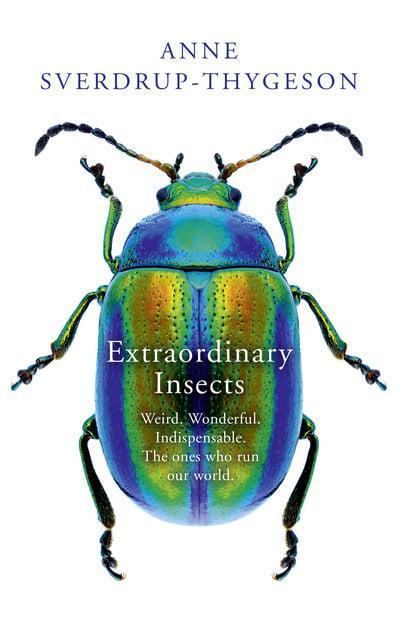Outreach & science communication
Anne Sverdrup-Thygeson (translated from the Norwegian by Lucy Moffatt)
Mudlark, an imprint of HarperCollins Publishers
2019
ISBN: 9780008316358
Reviewed by Stuart Reynolds
This is a fun book about insects for almost every kind of reader, whether they are kids interested in creepy-crawly bugs, amateur enthusiasts for the natural world, PhD students working on a hexapod thesis, or even retired professors of entomology. It starts with a riveting statement: “There are more than 200 million insects for every human being living on Planet Earth today”. Wow! (Is that true? … I’ve no idea). What a way to begin!
The book is absolutely packed with interesting and entertaining anecdotes about our hexapod friends, many of which were new to me. There’s no doubt that this book is a good way to introduce the reader who doesn’t know much about insects to the importance of the six-legged world, and indeed this is the way in which the publishers promote it. The striking dust cover has a very fine iridescent image of a beetle that is highly noticeable from the other side of the bookshop. In fact, I think that cover probably has a great deal to do with the fact that book is selling very well. It was a great Christmas present book last year and will probably be so again and again.
The author is a Norwegian academic entomologist who researches on biodiversity conservation with special emphasis on insects and trees (very appropriate in Norway!) but her interests in entomology go a lot further than that, and there really aren’t many areas of insect science that she doesn’t tackle.The book’s chapters run the gamut from insect sex, food webs, insect–plant co-evolution, insects and human food, the place of insects in the grand scheme of nature, insect natural products, insects as models in scientific research, right through to a final chapter in which the author mulls over the importance of insects to planet Earth.
The text is highly accessible; it’s definitely not written in scholarly mode, and the author takes a lot of trouble to make it both readable and indeed often humorous. I have to admit that sometimes, the choice of language made me cringe (an example: the firefly Photuris versicolor is said to flash “like a short-circuiting Christmas tree” – surely not?) and the author’s sense of humour isn’t always the same as my own (there’s a section entitled “When nature calls and insects answer” – of course, it’s about dung beetles… Geddit?). Despite these slight reservations, the book is very well-researched and even has a section at the end documenting its sources and enabling a proper scholarly follow-up for those (like me) who can’t resist exploring where all this stuff comes from at a deeper level.
And yet… I fretted over the whether the book has a message. In the end it isn’t very satisfying. I feel rather churlish in
complaining about this, because I can’t deny that the book does sterling work in introducing the extraordinarily diverse world of insects. But because it tries to cover so much it remains a series of anecdotes; it doesn’t dig deep. With so many stories begun, almost none of them can be finished. Too often it seems more than a bit superficial, and I feel that even a novice entomologist will want more than this book can give.
Actually, it may be inevitable that books attempting to introduce us to the world of insects suffer to some extent from this problem; after all, with around million or so different described kinds of insects, it’s going to be very difficult to balance the tension between depth and breadth.The very first printed book on insects, the Theatrum Insectorum (“Theatre of Insects”) by Thomas Muffet (1553) suffered from exactly the same problem.
Anne Sverdrup-Thygeson’s book has many merits, but only time will tell if it continues to satisfy.To my mind, other books have succeeded better in conveying an overall picture of the importance of insect life. Here are three which seem to me manage better the tension between broad and deep. Although it’s now more than 50 years old, Life on a Little-known Planet by Howard Ensign Evans (1968) remains a really excellent book with which to inspire the wonder and curiosity that the insect world deserves. May Berenbaum’s (1995) Bugs in the System is (like the book reviewed here) accessible and perhaps a bit quirky but I think it’s a much better guide to the underlying science. And Dave Goulson’s A Buzz in the Meadow (2014) provides real insight into just how satisfying it is to understand the importance to us humans at so many different levels of insect life and its place in the natural world.


